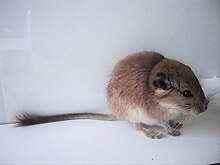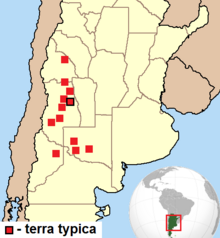| Plains viscacha rat | |
|---|---|

| |
| Conservation status | |
 Near Threatened (IUCN 3.1) | |
| Scientific classification | |
| Domain: | Eukaryota |
| Kingdom: | Animalia |
| Phylum: | Chordata |
| Class: | Mammalia |
| Order: | Rodentia |
| Family: | Octodontidae |
| Genus: | Tympanoctomys |
| Species: | T. barrerae |
| Binomial name | |
| Tympanoctomys barrerae (B. Lawrence, 1941) | |

| |
The plains viscacha rat, plains vizcacha rat, red viscacha rat, or red vizcacha rat (Tympanoctomys barrerae) is a species of rodent in the family Octodontidae native to Argentina. It is one of three species in the genus Tympanoctomys.
Description
The plains viscacha rat is a moderately-sized rat, with a large head, long tail, and short ears. Adults measure about 13 cm (5.1 in) in total length, with a 15 cm (5.9 in) tail, and weigh an average of 90 g (3.2 oz), with males being slightly larger than females. The rat has buff-yellow fur with white underparts, fading to dark brown at the tip of the tail.
Distribution and habitat
The plains viscacha rat is endemic to central western Argentina, where it has a fragmented range in Mendoza Province and western La Pampa. Its natural habitat is desert scrubland, dunes and salt flats, between 300 and 1,400 m (980 and 4,590 ft). There are no recognised subspecies.
The species is threatened by destruction of its fragmented and restricted habitat.
Biology and behaviour
Plains viscacha rats are solitary, and nocturnal. They construct complex burrow systems within large artificial mounds. Typical mounds are 13.6 by 8.7 m (45 by 29 ft) across, and 1.25 m (4 ft 1 in) in height, and have an average of 23 burrow entrances. Within the mound, the burrow system has up to three levels and contains numerous chambers and dead-end tunnels.
The rats are herbivorous, feeding primarily on halophytic vegetation, such as Atriplex and Suaeda, although they will occasionally eat other plants such as grass. The rats scrape off and discard salt from the leaves of Atriplex saltbushes with their teeth and bristles around their mouths before eating them. Although this reduces their salt intake, they still produce highly concentrated urine to help maintain their water balance.
The young are born blind, and weighing about 4 g (0.14 oz). Their eyes open at about six days, and they begin to take solid food at ten days.
Genetics

This species of rodent has (as of 2023) the third highest number of chromosomes of any known mammal (2n = 102), behind the tree pangolin (2n = 113/114) and the Bolivian bamboo rat (2n = 118).
It was described as the first known tetraploid (4x = 2n) mammal, thought to have arisen by hybridization and chromosome doubling from an ancestor (very possibly closely related to the mountain vizcacha rat, Octomys mimax, chromosome count 2x = 2n = 56). Some later studies have cast doubt on its tetraploid nature, while others have reasserted it. The doubling of its chromosome number was presumably by errors in mitosis or meiosis within the animal's reproductive organs. A comparison of the chromosomes of the plains viscacha rat and the mountain viscacha rat suggested that the chromosomes of the plains viscacha rat increased relatively rapidly (in evolutionary terms) due to a diverse set of highly repetitive elements. The animal's spermatozoa are roughly twice normal size, thought to be by virtue of having twice as many sets of chromosomes.
References
- ^ Roach, N. (2016). "Tympanoctomys barrerae". IUCN Red List of Threatened Species. 2016: e.T22586A78323698. doi:10.2305/IUCN.UK.2016-2.RLTS.T22586A78323698.en. Retrieved 12 November 2021.
- Lawrence, B. (1941), "A new species of Octomys from Argentina", Proceedings of the New England Zoological Club, 18: 43–46
- Woods, C.A.; Kilpatrick, C.W. (2005). "Infraorder Hystricognathi". In Wilson, D.E.; Reeder, D.M (eds.). Mammal Species of the World: A Taxonomic and Geographic Reference (3rd ed.). Johns Hopkins University Press. p. 1573. ISBN 978-0-8018-8221-0. OCLC 62265494.
- Pablo Teta; Ulyses F. J. Pardiñas; Daniel E. Udrizar Sauthier i Milton H. Gallardo (2014), "A new species of the tetraploid vizcacha rat Tympanoctomys (Caviomorpha, Octodontidae) from central Patagonia, Argentina", Journal of Mammalogy, 95 (1): 60–71, doi:10.1644/13-MAMM-A-160, hdl:11336/22721
- ^ Diaz, G.B.; et al. (2000). "Tympanoctomys barrerae" (PDF). Mammalian Species. 646: 1–4. doi:10.1644/1545-1410(2000)646<1:tb>2.0.co;2. Archived from the original (PDF) on 2016-03-04. Retrieved 2015-07-11.
- Mares, Michael A. (1 November 2003). "Desert dreams: seeking the secret mammals of the salt pans - Naturalist at Large" (PDF). Natural History: 29–34.
- Torres-Mura, J.C. (1989). "Herbivorous specialization of the South American desert rodent Tympanoctomys barrerae". Journal of Mammalogy. 70 (3): 646–648. doi:10.2307/1381442. JSTOR 1381442.
- Mares, M.A.; et al. (1997). "How desert rodents overcome halophytic plant defenses". BioScience. 47 (11): 699–704. doi:10.2307/1313210. JSTOR 1313210.
- Diaz, G.B. & Ojeda R.A. (1999). "Kidney structure and allometry of Argentine desert rodents". Journal of Arid Environments. 41 (4): 453–461. Bibcode:1999JArEn..41..453D. doi:10.1006/jare.1998.0472.
- Evans, Ben J.; Upham, Nathan S.; Golding, Brian G.; Ojeda, Ricardo A.; Ojeda, Agustina A. (2017). "Evolution of the largest mammalian genome". Genome Biology and Evolution. 9 (6): 1711–1724. doi:10.1093/gbe/evx113. PMC 5569995. PMID 28854639.
- Houck, Marlys L.; Koepfli, Klaus-Peter; Hains, Taylor; Khan, Ruqayya; Charter, Suellen J.; Fronczek, Julie A.; Misuraca, Ann C.; Kliver, Sergei; Perelman, Polina L.; Beklemisheva, Violetta; Graphodatsky, Alexander; Luo, Shu-Jin; O’Brien, Stephen J.; Lim, Norman T.-L.; Chin, Jason S. C. (2023-04-12). "Chromosome-length genome assemblies and cytogenomic analyses of pangolins reveal remarkable chromosome counts and plasticity". Chromosome Research. 31 (2): 13. doi:10.1007/s10577-023-09722-y. ISSN 1573-6849.
- Dunnam, J. L.; Salazar-Bravo, J.; Yates, T. L. (2001). "The Bolivian Bamboo Rat, Dactylomys boliviensis (Rodentia: Echimyidae), a new record for chromosome number in a mammal". Mammalian Biology. 66 (2): 121–126 – via Springer.
- Svartman, Marta; Stone, Gary; Stanyon, Roscoe (2005). "Molecular cytogenetics discards polyploidy in mammals". Genomics. 85 (4): 425–30. doi:10.1016/j.ygeno.2004.12.004. PMID 15780745.
- Graphodatsky, Alexander S.; Trifonov, Vladimir A.; Stanyon, Roscoe (12 October 2011). "The genome diversity and karyotype evolution of mammals". Molecular Cytogenetics. 4 (1): 22. doi:10.1186/1755-8166-4-22. PMC 3204295.
- ^ Gallardo, M.H.; González, CA; Cebrián, I (2006), "Molecular cytogenetics and allotetraploidy in the red vizcacha rat, Tympanoctomys barrerae (Rodentia, Octodontidae)", Genomics, vol. 88, no. 2 (published August 2006), pp. 214–221, doi:10.1016/j.ygeno.2006.02.010, PMID 16580173
- "New analysis of rare Argentinian rat unlocks origin of the largest mammalian genome". PhysOrg. 2017-07-12. Retrieved 2017-07-17.
- Gallardo, M.H.; et al. (1999). "Discovery of tetraploidy in a mammal". Nature. 401 (6751): 341. Bibcode:1999Natur.401..341G. doi:10.1038/43815. PMID 10517628. S2CID 1808633.
| Extant species of family Octodontidae | |
|---|---|
| |
| Aconaemys | |
| Octodon | |
| Octodontomys | |
| Octomys | |
| Pipanacoctomys | |
| Spalacopus | |
| Tympanoctomys | |
| Category | |
| Taxon identifiers | |
|---|---|
| Tympanoctomys barrerae |
|